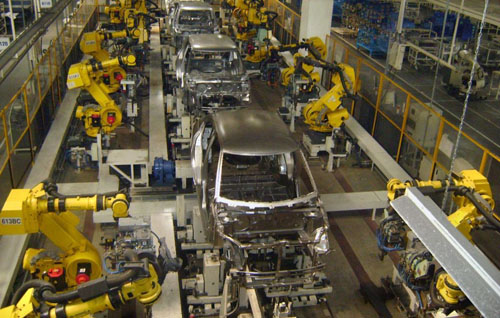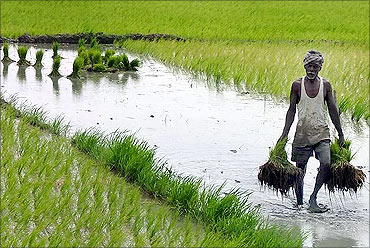
Is there a play-off between equity and efficiency? You bet. If India finds it a challenge to sustain 8 per cent economic growth, think political economy.
Start with the explanation for food inflation: that demand has surged, especially in the countryside -- because of higher food procurement prices, higher wages for agricultural labour (rising faster than the growth rate and inflation), and the employment guarantee programme.
Rural folk are using the extra money to eat better; hence the surge in demand for fruit and vegetables, and the different protein foods.
Trouble is, no one knows how to deal with the resulting inflation. So you may have benefited the aam aadmi, but a key indicator of macro-economic balance has been flashing red for months.
. . .

The second indicator of economic imbalance is the growing trade deficit. Imports of goods now exceed exports by more than 50 per cent.
This is partly neutralised by the surplus on trade in services (think IT) and by remittances from non-resident Indians. Still, the total trade deficit is more than 3 per cent of GDP -- the highest in decades.
This is fine if there is a matching inflow of capital, but in today's world this could be a risky bet; you may end up running down forex reserves instead.
. . .

The safer short-term option is to cool domestic demand, so that imports get compressed. This means allowing the rupee to slip, as the Reserve Bank of India has done.
Again, the trouble is that this makes imports more expensive, and inflation is already high.
The third macro-economic number flashing red is the fiscal deficit, likely to climb to more than 5 per cent of GDP.
. . .

Tax collections will fall short as a result of the industrial slowdown and shrinking corporate profits; and the subsidy bill will overshoot provisions.
Four years ago, the deficit was only 3 per cent of GDP, but that was before the government embarked on big-ticket spending in the run-up to the 2009 elections.
Having done the fiscal damage, there was more than one way to bring the deficit back down, like increasing revenues and by getting the economy to grow faster. Both required major reforms, for which this government has had no appetite.
. . .

The only option left is to cut subsidies and curb spending in general, but this is worse than Hobson's choice.
Subsidy cuts will raise prices (more inflation), and expenditure cuts could eat into the government's favourite programmes.
There has been no period in recent memory when the three key numbers (the twin deficits and inflation) were all flashing red as busily as they are doing today.
. . .

All three indicators point to excess demand, and at least two of them are the direct consequence of decisions designed to serve the United Progressive Alliance's (UPA's) declared objectives.
In a buoyant environment, you could grow your way out of trouble. But the world is not a buoyant place and, with key indicators stretched, the government has little room for manoeuvre.
The only option is to cool demand. In other words, cut back on spending and aim for slower growth.
. . .

There is cause and effect. The spending splurge has achieved greater equity. But it has created macro-economic pressures and affected savings and investment, so growth will slow down.
Many would happily settle for 8 per cent growth, rather than 9 per cent, if greater equity was part of the package. But then, could faster growth generate more jobs, and more tax revenue with which to pay for aam aadmi programmes?
The answer will tell us whether UPA policies have been politically sound only in the short term (winning in 2009), and economically counterproductive in the medium to long term.